
The bronze corydoras, also known as the green corydoras, bronze catfish, lightspot corydoras or wavy catfish, is a species of freshwater fish in the armored catfish family, Callichthyidae, often kept as an aquarium fish. It is widely distributed in South America on the eastern side of the Andes, from Colombia and Trinidad to the Río de la Plata basin; however, as presently defined it is a species complex and a taxonomic review is necessary. It was originally described as Hoplosoma aeneum by Theodore Gill in 1858 and has historically also been referred to as Callichthys aeneus.

Corydoras paleatus is a species of catfish of the family Callichthyidae. Its common names include blue leopard corydoras, mottled corydoras, and peppered catfish. It originates from the lower Paraná River basin and coastal rivers in Uruguay and Brazil.
The blackstripe corydoras or Bond's catfish is a tropical freshwater fish belonging to the Corydoradinae sub-family of the family Callichthyidae. It originates in inland waters in South America, and is found in the Yuruarí River in Venezuela and the Corantijn and Rupununi River basins in Guyana and Suriname. In the system of "C-Numbers" developed by the German fishkeeping magazine DATZ to identify undescribed species of Corydoras in the aquarium hobby, this fish had been assigned number "C31" until it was correctly identified.
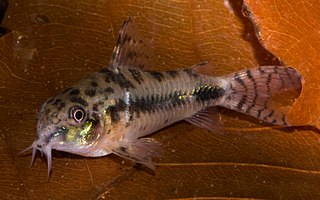
The salt and pepper catfish is a tropical freshwater fish belonging to the Corydoradinae sub-family of the family Callichthyidae. It originates in inland waters in South America, and is found in the Upper Orinoco River basin in Venezuela and Colombia.
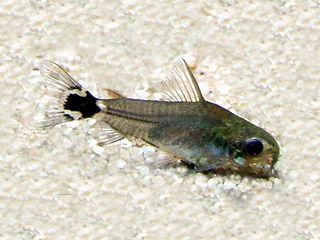
The dwarf corydoras, dwarf catfish, tail spot pygmy catfish, or micro catfish is a tropical freshwater fish belonging to the subfamily Corydoradinae of the family Callichthyidae. It originates in inland waters in South America, and is found in the Amazon River and Paraguay River basins in Argentina, Bolivia, and Brazil. The specific epithet hastatus means with a spear, in reference to the spearhead-like spot on the tail root.

The green gold catfish is a tropical freshwater fish belonging to the Corydoradinae subfamily of the family Callichthyidae. It originates in inland waters in South America, and is found in the Meta River basin in Colombia.
The bluespotted corydoras, blacksail corydoras, blackspotted corydoras, dotted corydoras, Guiana cat or Guiana corydoras is a tropical freshwater fish belonging to the Corydoradinae sub-family of the family Callichthyidae. It originates in inland waters in South America, and is found in the coastal rivers of French Guiana, Guyana, and Suriname. The specific epithet melanistius means black sail, referring to the dorsal fin.
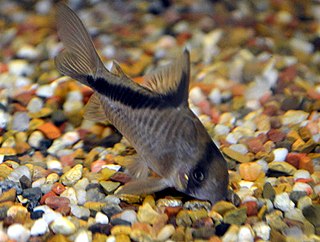
Corydoras melini, the bandit corydoras or false bandit catfish, is a tropical freshwater fish belonging to the subfamily Corydoradinae of the family Callichthyidae. It originates in inland waters in South America, and is found in the upper Rio Negro and Meta River basins in Brazil and Colombia.
Corydoras narcissus, commonly known as the long nosed arched cory, is a freshwater fish belonging to the Corydoradinae subfamily of the family Callichthyidae, native to the Madeira and Purus river basins in Amazonian Brazil. It has a longer, more concave ("saddle-shaped") nose, but its color pattern resembles that also seen in a few other Corydoras species from the western Amazon basin, as well as Brachyrhamdia thayeria; they all have spiny fins with a painful but not dangerous venom and their similarity is an example of Müllerian mimicry. C. narcissus generally is an uncommon species in its range.
Corydoras ornatus, the ornate corydoras, is a tropical freshwater fish belonging to the Corydoradinae sub-family of the family Callichthyidae. It originates in inland waters in South America, and is found in the Lower Tapajós River basin in Brazil.
Corydoras osteocarus is a tropical freshwater fish belonging to the Corydoradinae sub-family of the family Callichthyidae. It originates in South America, and is found in the Orinoco River basin in Venezuela and coastal rivers in Suriname. In the system of "C-Numbers" developed by the German fishkeeping magazine DATZ to identify undescribed species of Corydoras in the aquarium hobby, this fish had been assigned number "C60" until it was correctly identified.
The Pastaza corydoras is a tropical freshwater fish belonging to the Corydoradinae sub-family of the family Callichthyidae. It originates in inland waters in South America, and is found in the Pastaza River basin in Ecuador. It is named for the river in which it is found.

Corydoras reticulatus, also called the reticulated corydoras, mosaic corydoras, network catfish, or network corydoras, is a tropical freshwater fish belonging to the Corydoradinae sub-family of the family Callichthyidae. It originates in inland waters in South America, and is found in the Lower Amazon River basin in Brazil.

Schwartz's catfish is a tropical freshwater fish belonging to the Corydoradinae sub-family of the family Callichthyidae. It originates in inland waters in South America, and is found in the Purus River basin in Brazil.
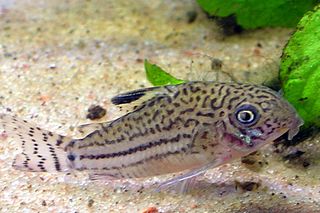
The three stripe corydoras, leopard catfish, false julii corydoras, or three line catfish is a tropical freshwater fish belonging to the subfamily Corydoradinae of the family Callichthyidae. It originates in inland waters in South America, and is found in the central Amazon River basin in Brazil and Colombia, Peruvian [Amazon and coastal rivers in Suriname.
The Xingu corydoras is a tropical freshwater fish belonging to the subfamily Corydoradinae of the family Callichthyidae. It originates in inland waters in South America, and is found in the upper Xingu River basin in Brazil. It is named for the river in which it is found. In the system of "C-Numbers" developed by the German fishkeeping magazine DATZ to identify undescribed species of Corydoras in the aquarium hobby, this fish had been assigned numbers "C55", "C105", "C106", "C107", and "C108" until these were correctly identified.

Corydoras julii is a small freshwater catfish native to eastern Brazil. It is often confused with Corydoras trilineatus, the three stripe corydoras. Corydoras julii are small, peaceful shoaling fish, and are typically kept in groups in captivity.
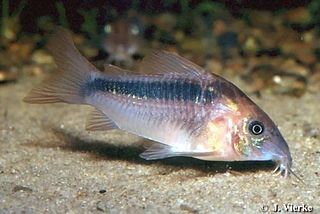
Corydoras rabauti, also known as the rust corydoras, or Rabaut's corydoras is a small species of tropical freshwater armoured catfish native to the Upper Amazon, Solimões, and Rio Negro basins in South America. It was first described by the American ichthyologist Francesca Raimonde La Monte in 1941, and is frequently seen in the aquarium trade.

Corydoras eques, the horseman's cory catfish or true eques cory, is a tropical freshwater fish belonging to the subfamily Corydoradinae of the family Callichthyidae. It was first described by Austrian zoologist Franz Steindachner. It is native to the Brazilian Amazon basin. The name eques means knight in Latin.











